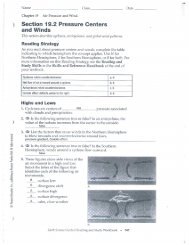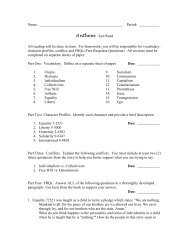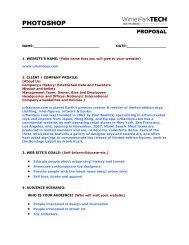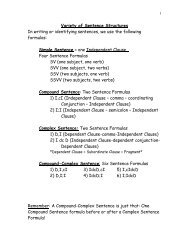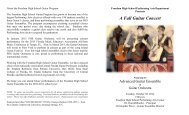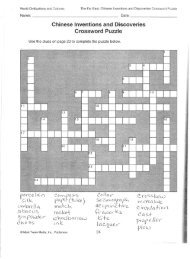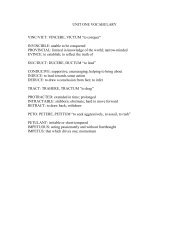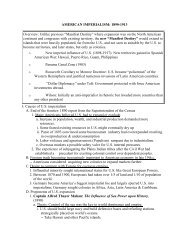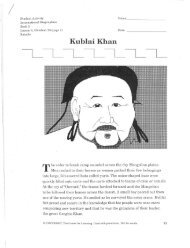Chapter 27 Empire and Expansion, 1890-1909 In the years after the ...
Chapter 27 Empire and Expansion, 1890-1909 In the years after the ...
Chapter 27 Empire and Expansion, 1890-1909 In the years after the ...
You also want an ePaper? Increase the reach of your titles
YUMPU automatically turns print PDFs into web optimized ePapers that Google loves.
8. <strong>In</strong> 1904 <strong>the</strong> construction of <strong>the</strong> Panama Canal began, <strong>and</strong> in 1914 just as World War I was<br />
beginning. Faced difficulties with labor troubles, l<strong>and</strong>slides, <strong>and</strong> lethal tropical diseases. Colonel<br />
William C. Gorgas dealt with <strong>the</strong> yellow fever <strong>and</strong> o<strong>the</strong>r diseases, making <strong>the</strong> area safe.<br />
TR's Perversion of Monroe's Doctrine<br />
1. Several nations of Latin America were in debt to European countries. President Roosevelt feared<br />
that if <strong>the</strong> European nations (mainly <strong>the</strong> Germany <strong>and</strong> Britain) got <strong>the</strong>ir feet in <strong>the</strong> door of Latin<br />
America, <strong>the</strong>n <strong>the</strong>y might remain <strong>the</strong>re, in violation of <strong>the</strong> Monroe Doctrine.<br />
2. Roosevelt <strong>the</strong>refore created a policy known as "preventive intervention." Knows as <strong>the</strong> Roosevelt<br />
Corollary to <strong>the</strong> Monroe Doctrine, it declared that in <strong>the</strong> event of future monetary problems of<br />
Latin American countries with European countries, <strong>the</strong> U.S. would intervene, take over <strong>the</strong><br />
customs houses, pay off <strong>the</strong> Latin American counties' debts <strong>and</strong> keep European nations out of<br />
Latin America. Did so first in <strong>the</strong> Dominican Republic in 1905.<br />
3. Did more than anything else to promote a “bad neighbor” policy. Latin American countries began<br />
to hate <strong>the</strong> Monroe Doctrine for it had become <strong>the</strong> excuse for numerous U.S. interventions in Latin<br />
America.<br />
Roosevelt on <strong>the</strong> World Stage<br />
1. Japan began war with Russia in 1904 <strong>after</strong> Russia failed to withdraw troops from Manchuria <strong>and</strong><br />
Korea. Japan was defeating Russia in <strong>the</strong> war when Japan's supply of troops <strong>and</strong> money began to<br />
run low.<br />
2. Japan <strong>the</strong>refore asked President Roosevelt (secretly) to step in <strong>and</strong> sponsor peace negotiations.<br />
Roosevelt agreed. He wanted to avoid a complete Russian collapse because he wanted a<br />
counterweight to Japan’s growing power.<br />
3. <strong>In</strong> 1905 <strong>the</strong> treaty to end <strong>the</strong> Russo-Japanese War was signed. Nei<strong>the</strong>r side was satisfied, but it<br />
captures <strong>the</strong> Nobel Peace Prize for TR in 1906. Because of <strong>the</strong> treaty, friendship with Russia faded<br />
away <strong>and</strong> Japan became a rival with America in Asia.<br />
Japanese Laborers in California<br />
1. When <strong>the</strong> Japanese government lifted its ban on its citizens emigrating in 1884, thous<strong>and</strong>s of<br />
Japanese were recruited to work in California. More came <strong>after</strong> <strong>the</strong> end of <strong>the</strong> Russo-Japanese<br />
War. Japanese immigrants were confronted with racist hostility by whites who feared a new<br />
“yellow peril”.<br />
2. <strong>In</strong> 1906, San Francisco's school board segregated <strong>the</strong> Chinese, Japanese, <strong>and</strong> Korean students to<br />
make room for white students. The Japanese saw this action as an insult <strong>and</strong> threatened with war.<br />
3. President Roosevelt invited <strong>the</strong> entire San Francisco Board of Education to <strong>the</strong> White House to<br />
settle <strong>the</strong> dispute. TR broke <strong>the</strong> deadlock <strong>and</strong> <strong>the</strong> Californians were persuaded to repeal <strong>the</strong><br />
segregation <strong>and</strong> to accept what came to be known as <strong>the</strong> "Gentlemen's Agreement." The Japanese<br />
agreed to stop <strong>the</strong> flow of immigrants to <strong>the</strong> United States.<br />
4. Concerned that his intercession in <strong>the</strong> CA-Japanese dispute might be seen as fear, TR decided to<br />
impress <strong>the</strong> strength of <strong>the</strong> US upon <strong>the</strong> Japanese <strong>and</strong> <strong>the</strong> rest of <strong>the</strong> world. He sent <strong>the</strong> entire<br />
battleship fleet (<strong>the</strong> Great White Fleet) on a highly visible voyage around <strong>the</strong> world, where <strong>the</strong>y<br />
were welcomed at every port.<br />
5. A rousing reception by <strong>the</strong> Japanese was <strong>the</strong> high-point of <strong>the</strong> trip <strong>and</strong> brought diplomatic success<br />
in 1908, when <strong>the</strong> Root-Takahira agreement was reached with Japan. The U.S. <strong>and</strong> Japan pledged<br />
<strong>the</strong>mselves to respect each o<strong>the</strong>r's territorial possessions.




